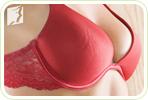Experiencing chest and breast pain is a common side effect of menopause, and it can be addressed. While many women may be used to the tenderness and ache in the breast area through decades of premenstrual syndrome (PMS), some women develop the sensitivity during menopause.
It can be alarming when the slightest touch or movement causes pain, and it may lead you to wonder if there are any serious issues taking place. Although it is important to go to the doctor if your pain becomes chronic, there are ways to differentiate between normal breast pain, and breast pain that should be more concerning.
Cyclic Mastalgia
Cyclic mastalgia - also known as cyclic mammaglia, mastodynia, or breast pain - is the condition most commonly associated with menopause and other hormonal changes. It usually occurs during and right before a woman's menstruation and is characterized by a heaviness and tenderness that can be painful and sometimes disruptive.
The pain in cyclic mastalgia is always temporary, but it can return when the body is under similar hormonal conditions, such as menopause. It is typically no cause for concern, besides the immediate inconvenience and discomfort it poses.
Non-cyclic Mastalgia
Non-cyclic mastalgia is chest and breast pain that remains for long periods of times as a result of arthritis or physical trauma. Instead of the pain shifting throughout the breast region, it remains in one affected area for extended spans of time. This type of breast pain can be more serious, since it has a clear cause that cannot be cured unless addressed.
Many women visit a doctor for pain management techniques to cope with the sharp pain. Though not life-threatening, this form is more long lasting without medical assistance, and may indicate arthritis or another underlying condition. It is important to see a doctor if you have constant breast pain.
Dangerous Symptoms
If a woman notices discharge, discoloration, skin irritation, a new lump, along with pain that does not subside, then it is important to seek immediate medical attention. Under no circumstances should cyclic or non-cyclic mastalgia display these symptoms. It can indicate dangerous infection or even breast cancer, so it is essential to take action immediately upon noticing abnormal chest and breast pain accompanied by other signs.
Herbal Remedies
There are herbal remedies available for treating cyclical breast pain associated with hormonal changes caused by the menstrual cycle or menopause. These herbal remedies, whether in tea or supplemental form, have been used by women for hundreds of years. One popular remedy, found primarily in Europe, is chasteberry. This plant is regularly prescribed in European nations to women experiencing cyclic mastalgia. It is also helpful for reducing symptoms of PMS, like cramps and headaches. However, because it impacts hormones, women on birth control, pregnant women, and women with a hormone-sensitive condition such as breast cancer should not take chasteberry.
If you are going through menopause, it is likely that you are experiencing the temporary and treatable cyclic breast pain. If you find that your complications go beyond hormonal causes, make sure to seek immediate assistance. It is also important to talk to your doctor before you start taking herbal supplements, because even natural medicine has side effects and the active components in herbs can interact with other medicines you are are taking.
Sources
- Harvard Medical School. (2005). Breast Pain. Retrieved May 29, 2014, from http://www.health.harvard.edu/press_releases/breast_pain
- National Institutes of Health. (2012). Breast Pain: MedlinePlus Medical Encyclopedia. Retrieved May 29, 2014, from http://www.nlm.nih.gov/medlineplus/ency/article/003152.htm
- NYU Langone Medical Center. (2013). Chasteberry. Retrieved May 29, 2014, from http://www.med.nyu.edu/content?ChunkIID=21649




